Physical Address
304 North Cardinal St.
Dorchester Center, MA 02124
Most types of inflammatory lesions of the esophagus do not manifest as endoscopically recognizable polyps. They instead cause only a slight mucosal irregularity or surface erosion. In contrast, most neoplastic processes of the esophagus manifest clinically at an advanced pathological stage. Malignant tumors may form strictures, plaquelike masses, or deeply penetrating or fungating ulcers. Polyps, which are discrete, well-circumscribed luminal protrusions, are uncommon in the esophagus. However, many unusual types of tumors of the esophagus are polypoid. Although esophageal polyps are rare, they often have interesting or unusual pathology.
Esophageal polyps may be divided into epithelial and mesenchymal types. Each type can be further subdivided as benign or malignant. The epithelial nature of an esophageal polyp is usually apparent at endoscopy or on radiographic evaluation because of the formation of a mucosal irregularity. In contrast, most mesenchymal polyps originate within the subepithelial tissues, causing an endoscopically recognizable elevation of the overlying mucosa, but the latter is usually left intact with a smooth contour.
Small polyps covered by benign (nonneoplastic) squamous epithelium may develop anywhere in the esophagus ( Table 19.1 ). The pathogenesis and morphological features of these polyps tend to correlate roughly with their site of origin. The two main types of squamous polyps are inflammatory polyps and squamous papillomas.
| Type of Lesion | Pathological Features | Clinical and Pathogenetic Features |
|---|---|---|
| Benign | ||
| Inflammatory polyp | Smooth rounded surface; irregular tongues of squamous epithelium; inflamed lamina propria | GEJ, reflux related, represents an exaggerated response to mucosal injury |
| Hyperplastic polyp | Foveolar hyperplasia, cystic change, regenerative changes, inflammation, ulceration; may also have hyperplastic squamous epithelium | GEJ, associated with chronic mucosal injury usually due to GERD |
| Squamous papilloma | Finger-like squamous papillae with underlying fibrovascular cores of lamina propria | Exophytic, distal esophagus, most common; also endophytic and spiked Often associated with HPV |
| Gastric heterotopia | Surface and gland epithelium lamina propria | Proximal esophagus; congenital; also called “inlet patch” |
| Glycogenic acanthosis | Larger clear squamous cells; endoscopic nodule, PAS+ | Increased intracellular glycogen level; if numerous, consider Cowden’s syndrome |
| Precursor Lesions | ||
| Polypoid dysplasia | Resembles colonic adenoma | Setting of Barrett’s esophagus |
| Squamous dysplasia | Nuclear atypia and loss of polarity; mild, moderate, or severe | Precursor to squamous cell carcinoma and spindle cell carcinoma |
| Malignant | ||
| Spindle cell carcinoma | Biphasic, squamous and spindle cells; keratin+, either component can metastasize | Better prognosis than conventional SCCA as exophytic morphology leads to earlier diagnosis |
| Squamous cell carcinoma | Usually strictured, ulcerated, or fungating mass | Rarely polypoid |
| Adenocarcinoma | Usually strictured, ulcerated, or fungating mass | Rarely polypoid |
Inflammatory polyps are the most common type of benign, squamous esophageal polyp ( Box 19.1 ). They occur primarily in men at the lower esophageal junction and usually are associated with gastroesophageal reflux disease (GERD). Inflammatory polyps represent an exaggerated response to mucosal injury. Some are exuberant, healed ulcer sites. Inflammatory polyps may also develop proximal to the gastroesophageal junction, where they are often associated with mucosal injury caused by embedded pills, infection, or surgical anastomoses.
Most common type of benign, squamous esophageal polyp
Male, gastroesophageal junction, reflux-associated
Smooth, rounded surface with irregular tongues of squamous epithelium extending deeply within an inflamed lamina propria
Key differential diagnosis:
May resemble endophytic squamous papillomas and may be HPV associated; but these are less frequently diagnosed
Histologically, inflammatory polyps often have a smooth, rounded surface and consist of irregular tongues of squamous epithelium that extend deeply within an inflamed lamina propria ( Fig. 19.1 ). Although controversial, some investigators think these polyps represent an endophytic type of squamous papilloma. Human papillomavirus (HPV) was identified in 33% of these polyps by polymerase chain reaction analysis in a study by Odze and colleagues. HPV was postulated to be a promoter of epithelial growth in mucosa that had been damaged by other irritants such as GERD.
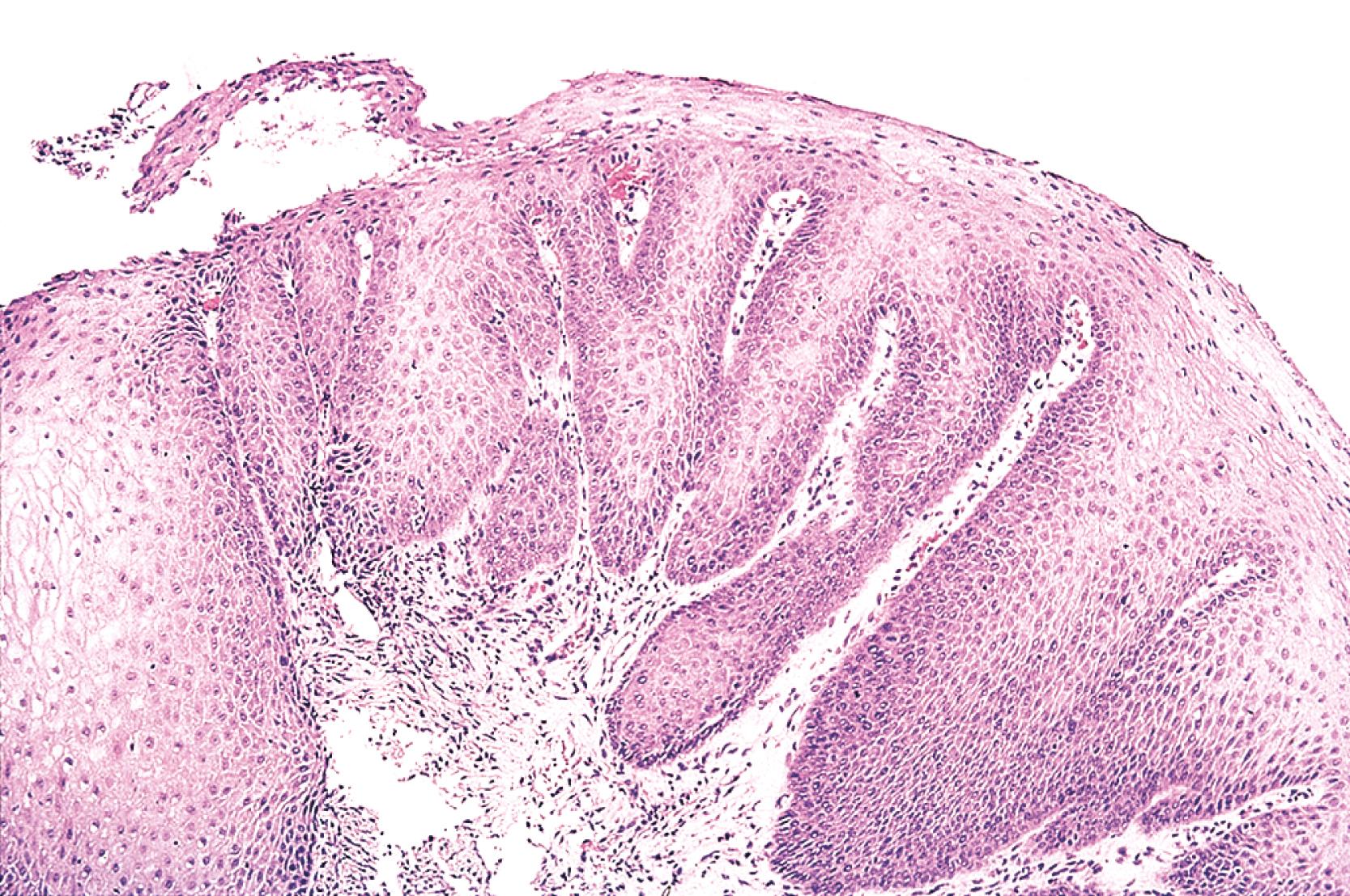
At the level of the gastroesophageal junction, hyperplastic polyps composed primarily of gastric hyperplastic foveolar epithelium ( Fig. 19.2 ), with or without hyperplastic and regenerative-appearing squamous epithelium, can develop, presumably as a result of chronic mucosal injury. These gastroesophageal junction polyps have been most often reported in the clinical gastroenterology or radiology literature. Hyperplastic polyps at the gastroesophageal junction may be associated with a short or ultrashort Barrett’s esophagus (33% of cases), and they have less inflammation compared with those arising in a non-Barrett’s setting.
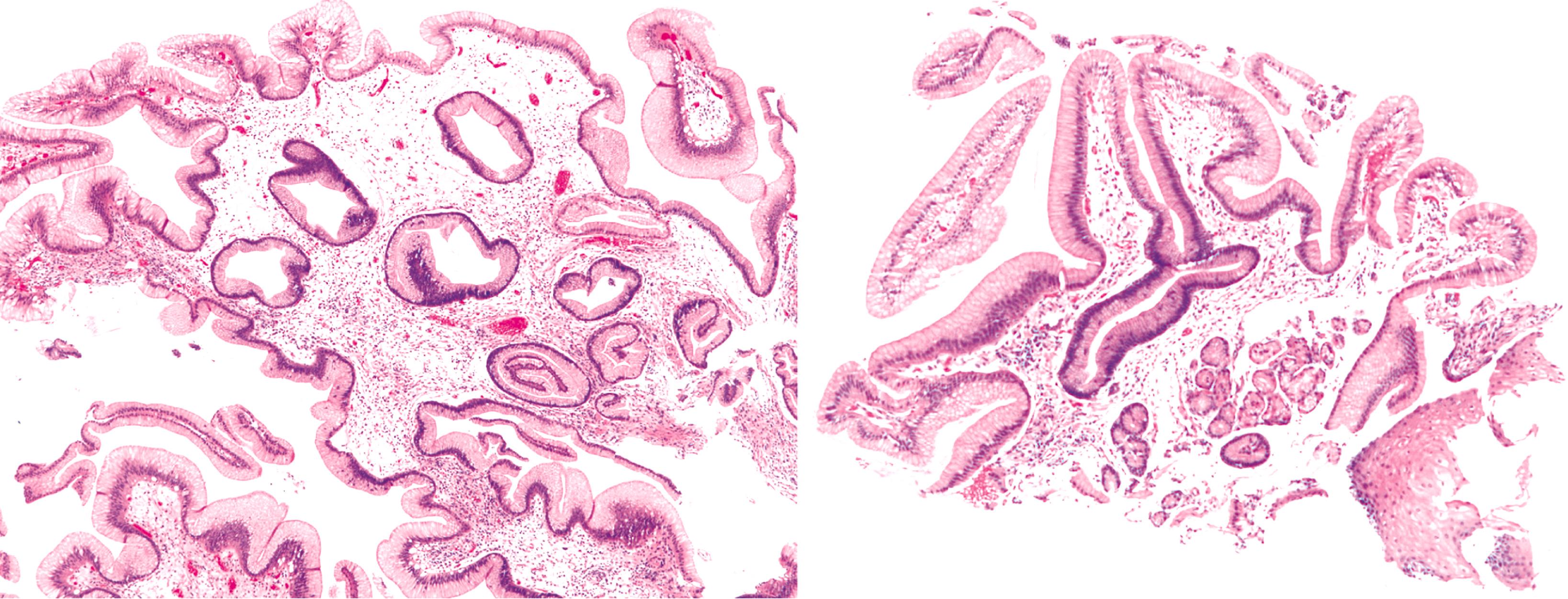
Squamous papillomas are the other main type of squamous polyp of the esophagus (see Chapter 24 ) ( Box 19.2 ). They are the most common benign tumor of the esophagus and can occur at any age. , The reported frequency of squamous papilloma ranges from 0.01% to 0.26% in Europe , and 0.1% to 0.2% in Asia. , The presence of multiple polyps (squamous papillomatosis) should raise the possibility of a hereditary syndrome.
Exophytic is most common histological pattern
Finger-like squamous papillae overlying fibrovascular cores of lamina propria
May have koilocytic features
May be HPV associated
Endophytic has a smooth, round surface with inverted papilloma appearance
Spiked are least common, with verrucous appearance, corrugated surface, hyperkeratosis, and prominent granular cell layer
Benign but small risk for associated malignancy
Key differential diagnoses:
Fibrovascular polyp: usually upper esophagus, larger at presentation
Squamous dysplasia and carcinoma: nuclear atypia, invasive component
Three main histological patterns have been described: exophytic , endophytic , and spiked . The exophytic type is more common. On endoscopy, these lesions are a few millimeters in size and have a cauliflower-like appearance. Histological examination of the exophytic type reveals finger-like squamous papillae overlying fibrovascular cores of lamina propria ( Fig. 19.3 ). The squamous epithelium may have features of koilocytosis, but it usually lacks the large, hyperchromatic nuclei and binucleation typical of HPV-infected cervical epithelium. Exophytic squamous papillomas occur most frequently in the distal esophagus, but they also occur in the middle and upper esophagus. HPV is associated with as many as 78% of these squamous papillomas, , although much lower HPV associations have also been reported. For instance, Takeshita et al. reported HPV in 10.5% of squamous papillomas. All of these were located in the middle esophagus of female patients. Recent studies have also found high-risk HPV phenotypes in up to 50% of squamous papillomas. ,
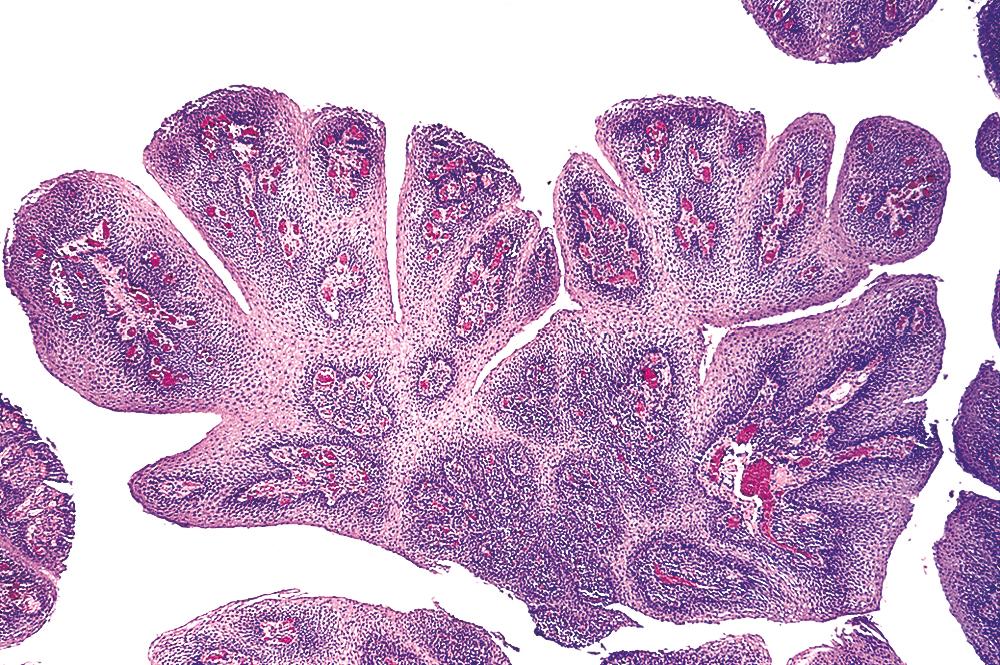
The endophytic type of papilloma has a round, smooth surface and an inverted papillomatous appearance. Some investigators think they are inflammatory polyps. Spiked squamous papillomas have a verrucous appearance, a corrugated surface, hyperkeratosis, and a prominent granular cell layer. This is the least common form of squamous papilloma. Forty percent of spiked papillomas were shown to harbor HPV in one study. Ratoosh and coworkers described a 60-year-old woman who had a large, verrucous lesion of the distal esophagus and multiple warts on her distal fingertips. HPV-45 DNA sequences were identified in the fingertip and esophageal verrucous lesions, suggesting autoinoculation of the finger wart HPV virus to the esophagus.
Squamous papillomas are benign. Rarely, large squamous papillomas have undergone malignant degeneration. However, whether these lesions represent de novo carcinomas or true malignant degeneration of a squamous papilloma is unknown. Due to the very low risk of malignancy, squamous papillomas should be excised.
Several types of esophageal heterotopias rarely manifest as polypoid lesions on endoscopy (see Chapter 24 ). Heterotopias occur in 10% of the general population and usually consist of gastric heterotopia, although thyroid, parathyroid, and ectopic sebaceous tissues ( Fig. 19.4 ) have been described. Gastric heterotopias in the esophagus usually contain glands and foveolar epithelium (82% of cases) and are thought to be congenital in origin. Heterotopias are often found in the proximal esophagus and may be called an inlet patch on endoscopy. These lesions are distinct from Barrett’s esophagus, as described in Table 19.2 .
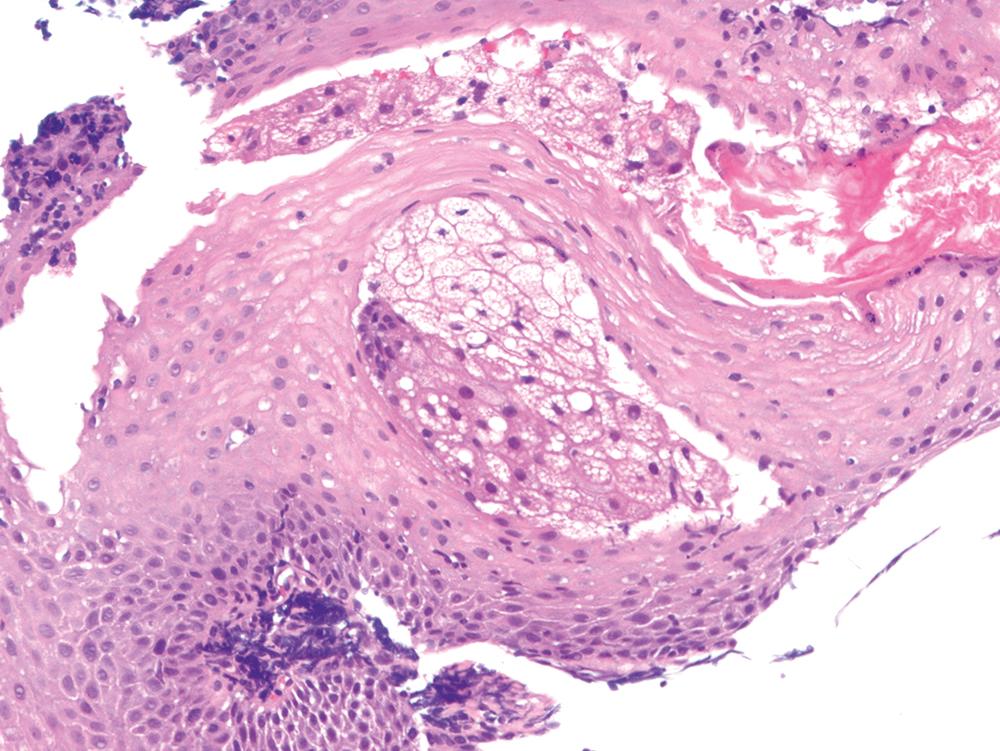
| Feature | Heterotopic gastric inlet patch | Barrett’s esophagus |
| Clinical | Incidental, congenital | Reflux associated |
| Location | Proximal esophagus | Distal esophagus |
| Endoscopy | Salmon-colored, velvety patch surrounded entirely by normal gray-white esophageal squamous mucosa | Salmon-colored tongues extending at least 1 cm proximal to, and contiguous with, the GEJ |
| Histology | Gastric epithelium: glands may be mucinous, oxyntic, or both Typically not inflamed Normally no goblet cells |
Goblet cells (intestinal epithelium), may be incomplete: interspersed among gastric-type epithelium |
Small, plaquelike or nodule-like lesions can occur in patients with prominent glycogenic acanthosis. They represent focal nodular thickening of the squamous mucosa with cells that contain prominent intracytoplasmic glycogen, seen histologically as clear cytoplasm ( Fig. 19.5 ). Endoscopically, the lesions can resemble squamous papillomas. Patients with Cowden’s syndrome or tuberous sclerosis may have numerous polypoid areas of glycogenic acanthosis, and this finding always raises the possibility of one of these diagnoses. , If making the diagnosis of multifocal glycogenic acanthosis in a patient not known to have already been diagnosed with a syndrome, it is helpful to state in a comment that these clinical syndromes should be considered.
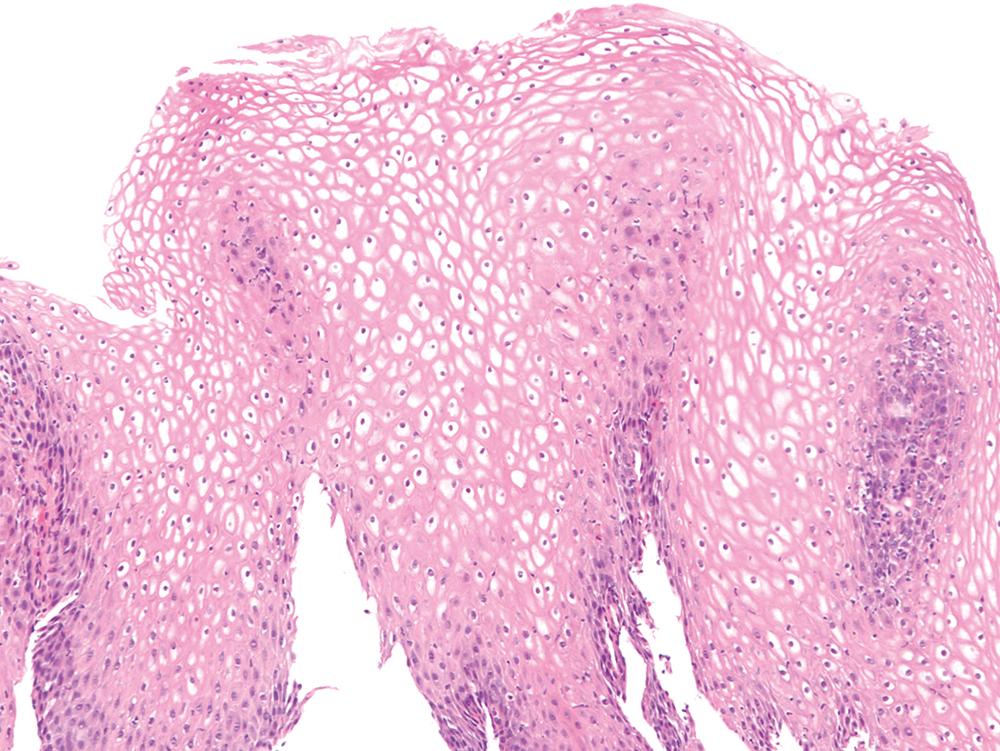
Become a Clinical Tree membership for Full access and enjoy Unlimited articles
If you are a member. Log in here